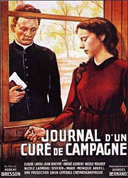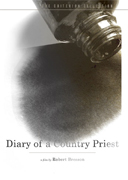
|
DVD Review by Doug Cummings / robert-bresson.comDiary of a Country Priest [ Le Journal d'un curé de campagne, 1951 ]Region 1: Criterion Collection, 2004
The Film
Much has been written about the film's success as an interior drama, a rare cinematic feat accomplished through Bresson's rigorous commitment to form. It's a cinema of introversion, depicting the "simplest and most insignificant secrets of a life actually lacking any trace of mystery" and narrated in hushed tones by the priest as he writes in his journal. A variety of scenes convey his insecurity (he backs down from a demanding parishioner, refrains from criticizing another, and agonizes over how he should address an infidelity). "I think you have the spirit of prayer," the priest of Torcy tells him after detailing a lengthy list of the priest's vocational failings, but it's a bitter irony--through a combination of physical and emotional suffering, the priest of Ambricourt's dark night of the soul undermines that as well. The priest's journal entries resemble confessions to the viewer and reflect the prominent role of writing throughout as personal expression and communion: a note written by the priest's sole church attendee pleads with him to leave the parish, his key to offsetting the hatred of a young woman, Chantal, occurs when he discovers her secret letter to her father, a countess he delivers from grief offers him a letter of gratitude, and even the final words of the film are read from a type-written correspondence. Diary's world is one of downcast eyes and hidden motivations, isolated souls and abbreviated expressions, the written word providing the cement that binds viewers to the protagonist, and the protagonist to his diegetic world. Bresson's decision to present his story elliptically challenges the viewer to heightened sensitivity and attention. When the priest describes his suffering through a "terrible night," both of the highly cinematic events he describes are never directly shown: a "shattering" in his breast that induced trembling for over an hour and his decision to lay face-down at the foot of his bed in order to show "complete acceptance." The viewer is only presented with the moments in between and after these episodes. The film's creative use of narration is another of its most celebrated features, a stylistic device Bresson would use in several of his films. As André Bazin would write:
"The most moving moments of the film are those in which the text and image are saying the same thing, each however in its own way... It is here at the edge that the event reveals its true significance. It is because the film is entirely structured on this relationship that, towards the end, the image takes on such emotional power. It would be in vain to look for its devastating beauty simply in what is explicit. I doubt if the individual frames in any other film, taken separately, are so deceptive." The ambient soundtrack is similarly integral to the film's affect. So much of the priest's world is conveyed through offscreen sounds--passing carts, dogs barking in the distance, nearby revelry, hunters in the woods, gardeners raking leaves--all the pitches and timbres carefully evoking a physical world just beyond the priest's reach. Sounds connect various scenes as well, such as the tolling church bells which ring in the only two scenes in the film involving graveyards. The paradoxical discovery of meaning in apparent absence serves as a primary theme of the film as well as its aesthetic model. The compositions repeatedly emphasize restrictive gates, doors, and windows. One of the most mysteriously hopeful scenes in the film occurs when the priest, having reclaimed his spiritual identity, suddenly rises from bed "with the feeling, the certitude that I had heard someone calling me." He walks over to his window and looks out, "Yet," he adds, "I knew I wouldn't find anyone." A large part of the film's intensity derives from its visual style, a mixture of close-ups and medium shots, short tracking camera movements along the lens axis during key moments of many scenes (there are only a handful of panning shots), and the use of dissolves and fades that fluidly merge each episode of the film like a rhythmic fever dream. L.H. Burel explained that he saw the movie as "something rather insubstantial or immaterial" which he wanted to convey without the use of heavy shadows. Originally toying with an idea similar to the high-contrast lighting of Carol Reed's The Third Man, Bresson was immediately enthused by the soft, "wet" look of Burel's early test footage produced from having lens diffusers incorrectly attached. "When I saw the rushes, I was appalled," Burel noted. "It wasn't diffused, it was out of focus." But Bresson insisted on the look and the film's overcast skies and low-contrast interiors lends it a special, luminous quality. High-contrast photography is saved for night interiors, when the priest's sense of isolation is the most severe. Seeing becomes a running motif throughout the film, befitting its themes of spiritual enlightenment and self-awareness. A child and her classmates tease the priest for having "beautiful eyes" and later a doctor tells him he has "faithful eyes." (In a later scene, the priest of Ambricourt admits to sometimes sharing the doctor's spiritual pain and imagines his sad eyes upon him, "eyes which I feared to read.") When Chantal expresses a vehement anger toward her governess, she declares, "You get used to her eyes. You imagine they're kind. Now I'd like to tear out those eyes of hers and stamp on them with my foot!" And a member of the Foreign Legion finally tells the priest, "You should see yourself. Without that black robe, you'd look like any one of us. I could see that right off the bat." Watching Diary today allows one to recognize the whiffs of Bressonian wisdom he would expound upon in later years. In one early conversation, the elderly priest of Torcy advises the priest of Ambricourt to "keep order all day long, knowing full well disorder will win out tomorrow," and we are reminded of Bresson's preference for the filmmaking title "metteur en ordre" ("one who puts things in order") rather than the typical French "metteur en scène," ("one who stages"). Bresson always gave a great emphasis to the rhythm and interaction of his various elements, writing that "a shot in a film is given its meaning by its context, and each shot modifies the meaning of the previous one." In a later scene, the priest challenges the countess to examine her inner life and she responds, "An hour ago, my life seemed to me in order, each thing in its place. You have left nothing standing." In another scene, Chantal asks the priest what he thinks of her and he claims that priest's have no opinion. "You have eyes and ears and make use of them like everyone else," Chantal quips, and he replies, "They would tell me nothing about you... You're always restless, hoping to conceal the truth of your soul or perhaps to forget it." This statement dovetails neatly into Bresson's comments on non-professional "models": "The thing that matters is not what they show me but what they hide from me and, above all, what they do not suspect is in them." Diary also differs in some respects from Bresson's other films. Although his increasing rigor inspired him to eventually dispense with the use of music altogether, Jean-Jacques Grünenwald's stirring and sensitive score plays throughout this film. It's a good score, but it's much more prescriptive accompaniment than Bresson would embrace in later years. It's possible the happiest scene in the film occurs when the priest is offered a motorcycle ride from a Foreign Legionnaire, an event that reminds him of his youth and freedom. As one of the only modern elements in the film's rural setting, the speeding cycle and its revving motor serve an inverse function to their destructive connotations in Au hasard Balthazar (1966). Diary is Bresson's longest film, clocking in at 115 minutes. Known for his brevity, Bresson's films often run less than 90 minutes. According to Bazin, Bresson was "forced to throw out a third of his final cut [45 minutes] for the exhibitor's copy, [and] he ended by declaring with a delicate touch of cynicism that he was delighted to have done so. Actually, the only 'visual' he really cared about was the blank screen at the finale." In America, distributors reportedly cut another ten minutes from the film, but it nevertheless remains Bresson's only widely-distributed movie in the US (previous to Rialto Pictures' latest efforts) and even received an award by the National Board of Review in 1954. The Transfer
It includes newly translated and removable English subtitles. For numerous screenshot samples, refer to DVDBeaver's review. The SupplementsUnfortunately, this is where the DVD could have used some improvement. Given Criterion's track record of producing many two-disc DVD sets with copious extras and given the fact that this release represents the first key work of Bresson released on DVD in North America, we feel it deserved a more elaborate package.The disc includes the original trailer for the film restored by the French National Center of Cinematography, which surprisingly contains many alternate takes and scenes from those used in the film. It also includes an audio commentary by film scholar Peter Cowie, which unfortunately is quite pedestrian. Cowie was the founding editor of the annual International Film Guide for forty years and he's a dependable historian of world cinema who has written over twenty books, many of which focus on Nordic films. He has provided good audio commentaries for past Criterion releases such as Wild Strawberries and Hiroshima mon amour. But to our knowledge, he hasn't made any serious contributions to Bressonian scholarship and given the informative but rare English writing on Bresson, we would've preferred that Criterion had enlisted a Bresson specialist, even if it would've necessitated the subtitling of a French commentary. The main disappointment of Cowie's commentary is that he spends vast portions of it reading from Bernanos' novel in order to compare Bresson's treatment with the source material, but this requires skipping over many formal details in scene after scene. The information he provides on Bresson seems either too colloquial (comparing Bresson to his favorite New York martinis) or questionable in its accuracy (he asserts that Bresson was an agnostic, thus dismissing decades of Jansenist commentary as well as Bresson's own varied statements on the subject). Cowie commendably notes that appreciation for Bresson can and does encompass a wider spectrum than Catholic thinkers alone, but he seems too eager to dismiss the specifically Catholic milieu of Diary for a few nebulous statements on religious values in general. He attempts to justify the film's universal value by reducing "all the major religions and philosophies" into the same basic idea of enlightenment. While we appreciate his concern for universality, it doesn't make for very rigorous textual or religious scholarship--it's doubtful there's a Buddhist, for example, who won't cringe when Cowie blithely defines Nirvana as a "state of grace." Other quibbles: Cowie quotes Bresson's comments about casting his models via phone conversations alone, but that quote was taken from the '70s. He makes a confounding dig at Carl Theodor Dreyer en route when he suggests that Dreyer's editing lacked a proper rigor and often exhibited "that Scandinavian deliberateness of tone that can, in its worst moments, seem like we're watching paint dry on his ascetic white walls." To make matters worse, Cowie then unfairly criticizes Bresson by saying, "Not that I'm against Dreyer, he possessed a humorous streak that unfortunately never entered Bresson's personality."
Many of Cowie's observations of the film's characters are also drawn from the novel rather than the film, thus he provides the sort of "background information" or even psychological detail that Bresson went to great pains to eliminate from his narrative.
|

